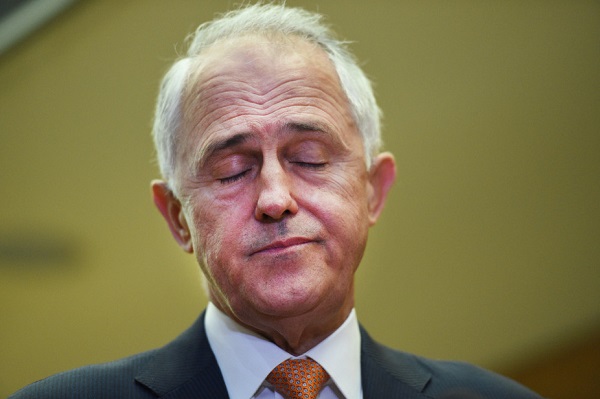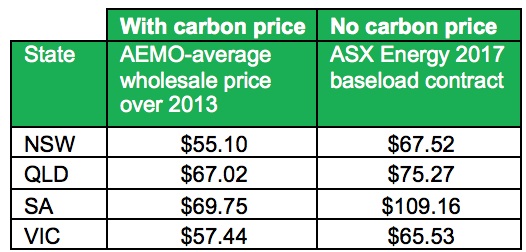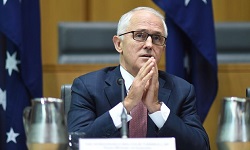A bit further down I’m going to look at what Tristan Edis has to say about electricity pricing, but first what the whole affair is doing to Turnbull.
Mark Di Stefano at Buzzfeed has a detailed account of Turnbull’s year in 2016: The Year That Broke Malcolm Turnbull, and the pictures follow the story. Turnbull starts out as a confident leader, full of hope and bright ideas, and ends as just another politician that people don’t like very much. And there is rising anger about him within the conservatives of his own party.
Michelle Grattan’s piece in Has Turnbull’s credibility deficit reached a point of no return? leads with an image that says it all:

She says:
-
Turnbull is letting the right inside and outside the Coalition progressively tighten their grip on him. He’s become, or maybe always was, a whatever-it-takes man, and it’s taking more and more to deal with situations as the power of the right strengthens, post Brexit, post Trump and in the age of Hansonism.
He’s caved on climate, but they will want more. Bernadi wants us out of the Paris Agreement. Finally:
- Columnist Andrew Bolt endorses Kevin Rudd’s assessment that Turnbull is the most ineffective conservative prime minister since Billy McMahon.
The future is always another land but it is hard to see how Turnbull can become anything like his own man in 2017. If he had secured a big rather than wafer-thin victory at the July election, he’d have some political capital – and that capital, like the financial kind, carries its own strength. As it is, he’s at the beck and call of those who hold the mortgage over him and, just now, they are not actually the voters.
The photo looks unfair. Yet arguably it only amplifies and illustrates the story.
Di Stefano quotes former Liberal MP Ross Cameron, now a political commentator:
- “The Turnbull government looks like a torn state, a conservative electoral base but a progressive tincture to its style of government,” Cameron told BuzzFeed News.
“It winds up with substantial risk of falling between stools.
“A chunk of the traditional base of the Liberal National Party is peeling off the peloton and looking for another group to join, whether that be One Nation, [Liberal Democrats], Shooters and Fishers.”
John Hewson piles in too, reminding us what Turnbull thought and said back in 2009.
- The broad-based electoral expectation that Turnbull would stand against all this [Abbott’s anti-climate change crusade] by continuing with his “principled position” on climate was soon thwarted, as it became clear that he had sold out to the “right” and the Nats to gain their support for him to replace Abbott as PM.
Lenore Taylor in Turnbull was right in 2009: ruling out emissions trading is ‘bullshit’ perhaps has the most fun of all in quoting Turnbull back to himself. She ends with this from Turnbull’s 2009 blog:
- “Politics is about conviction and a commitment to carry out those convictions. Many Liberals are rightly dismayed that on this vital issue of climate change we are not simply without a policy, without any prospect of having a credible policy, but we are now without integrity. We have given our opponents the irrefutable, undeniable evidence that we cannot be trusted,” he wrote.
She says it’s hard to put it better than that.
Hewson says the “right” is simply “wrong” about climate change and their children and grandchildren will pay the price.
Taylor, writing back in May, says Greg Hunt was always playing the long game, and always saw the Direct Action baseline concept developing into an emissions intensity trading scheme. Looks like Frydenberg dropped the ball.
All this is on the assumption that an ETS is a good idea. Tristan Edis looks at what is actually happening.
Tony Abbott argued that a carbon price would push electricity prices up, so destroying it should bring them down. Look what has happened:

He says that our existing coal power stations incur an operating cost of about $10 to $25 per megawatt-hour, which is cheap by international standards. However, the fleet is ageing and many need upgrades. Operators and financiers are unwilling stump up the costs, if coal is to be phased out. Hazelwood, almost 50 years old, was facing a major bill to bring the plant up to reasonable safety standards. French owner Engie is pulling the plug, because company policy world-wide is to get out of coal.
Gas may be part of the answer, but thanks to exports to Asia you’d need prices for power approaching $100 per megawatt-hour to induce new plants to be built.
- This then leaves renewable energy. What many people don’t realise is that over the last five years there has been considerable technological progress that means wind and solar are now noticeably cheaper than new gas or coal plant.
Our costs are a bit higher than international standards. Our labour costs are high, but similar to the US.
- So why are we paying so much more for renewable energy?
It’s mainly down to the fact that financiers see Australia as a much more risky place for investment in renewable energy. This means they charge much higher interest rates to Australian projects. Financiers see it as more risky because Australia’s regulatory environment is too uncertain and not aligned with government’s emission reduction targets. It also doesn’t help that every second day a government MP publicly accuses renewable energy as responsible for a range of ills, including even children drowning!
Now we have this:
- A pioneering wave power company says it is building its first commercial wave plant in Cornwall, England because the policy support for renewable energy there is more enticing than the climate policy chaos in Australia.
ASX-listed Carnegie Wave Energy got their start through ARENA, but are going to England because the support from the British government leaves us for dead.
Energy investment is done with a horizon of 30 to 40 years. Who can blame them given Turnbull’s propensity to cave to our alt-right political forces.
Finally here are a few links as to where we are now:
He says we are heading for the grand mal of energy system security failures, very much of the government’s making. He goes through the options available. An emissions intensity scheme subsidises clean and penalises dirty, roughly cancelling each other out. So behaviour changes over time at basically no extra cost. The market works, but with an imposed bias.
The suggestion, from market operator AEMO, is that a new interconnector should be built to connect NSW and SA, a second interconnector to Tasmania, an upgrade the interconnector between NSW and QLD, and perhaps a second between SA and Victoria (not sure, this one might be an alternative to the second with Victoria). Each would cost $500,000 to a billion. They are needed to make the network more resilient and to bring new renewables to the market. In the long run the expense would save money.
They also said:
- up to 12 gigawatts of new gas-powered generation may be required to replace coal-fired generators that could close in the next 20 years if technology does not improve.
Parkinson says that with modern technology it’s possible that the SA blackout in September, when the storm brought the power lines down, could have been avoided. In any case it is time to stop finger-pointing and work on modernising the grid.
He seems to be questioning whether the folks at AEMO are up to the job:
- For some reason, AEMO still wants to investigate whether the blackout would have occurred if the coal-fired power station at Port Augusta had still been running. It is still obsessed with the amount of synchronous and non synchronous generation and inertia.
But maybe now, after this report and the Finkel review, the market operators, the rule makers, the regulators and the policy makers should stop looking for the petrol cap [a reference to a car ana;ogy used by AEMO] and look to the future, not the past, for the right answers.


I think the overall problem here is that the Turnbull government’s climate policies are being seen by corporates and financiers as a “figleaf for doing nothing”, a phrase that I believe is attributable to Turnbull himself.
Turnbull is reaching a point where it is becoming clearer and clearer that the toxic right will stop him from doing the things that he appeared to want to do in the past. To make matters worse the toxic right has got to the point where it is publicly telling him what to do and being seen to be telling him what to do.
Perhaps he will have enough sense to resign as prime minister, resign from the liberal party and start voting for what he actually believes in. If a few others resign with him he may be able to work with the Labor party to achieve some of the things he used to claim to believe in.
A few comments:
Solar thermal towers with back-up molten salt heating have much the same characteristics as coal fired power stations with respect to their effect on the grid. (The power comes from steam powered generators in both cases.)
I find it difficult to believe that modern electrical engineers cannot solve the synchronization problem of running with up to 100% solar PV.
Both batteries and solar PV can be switched on and off very quickly. Fossil fueled and solar towers take much longer.
We pay a lot for electricity because:
1. We have to subsidize grid owners for the lousy decisions they have made in the past and the retailer rip-offs.
3. Systems that depend on things like the carbon tax and the RET don’t provide investor confidence. By contrast, contract based systems like the renewable energy auctions used here and overseas do provide the certainty of contracts and help drive down prices. (For example, this article talks about best practice auctions and the effect of moving to auctions on prices:
Our spot market adds to uncertainty.
We need “standby contracts” to encourage a limited number of fossil fuel generators to be maintained for the times when their back-up is needed.
John, following that link on renewable energy auctions, they have been used in the US, Canada, the UK, France and Germany, as well as China and India.
However, they seem to be off the table in Australia, apart from the ACT anomaly. Everything has to be private, competitive and entirely left to the volition of the market energy czars.
So the scheme Weatherall was promoting, which was what Danny Price developed back in 2009 for Turnbull, is the best of the rest.
AEMO proposed extra interconnector.
Price range $500k to a billion $
seems a bit wide.
Pedants Anon.
Tristan Edis from the linked article says
“a significant number of federal Liberal-National MPs (but not all) may happen to think human-induced climate change is a hoax”
…..is just too hard to fathom how that can be. Leading that brigade appears to be Cory Bernadi about whom his colleagues say…..
“Cory is deluded,” says a Liberal Party colleague. “He is one of the least effective or important members of the parliamentary team. Cory is a person without any intellect, without any base, and he should really never have risen above the position of branch president. His right-wing macho-man act is just his way of looking as though he stands for something.”
I was reading a Monthly article
https://www.themonthly.com.au/cory-bernardi-conservative-warrior-all-about-cory-sally-neighbour-4327
……….attempting to get some clue as to how anyone could hold those views, what sort of person is he?
My conclusion is provisionally that Bernadi has a narcisist personallity. His wife…
“says they have the perfect marriage because they’re “both in love with the same man”. “Cory obviously has this huge belief in himself … If you didn’t love a guy who was so in love with himself you’d have a lot of trouble living with Cory. Life – I don’t think he’d mind me saying this – it’s all about Cory. I am all about Cory, and he is all about Cory, so it makes it easy.”
So I think he fits into my theory very well. The question becomes how do you deal with someone who is prepared to passionately promote and drive an idea that is blatantly false, purely for political gain. Did I mention that Bernadi is Catholic?
I’m calling for some kind of great wisdom here.
Brian: The ACT does not build, own or operate any of the plants built under their auction scheme.
John, coming to think of it, hasn’t SA put out a tender for electricity supply, controversial in that they’ve classified gas as ‘clean’?
We’ll see how it goes, but the claim is that with the Danny Price EIS and a benchmark that lowers over time the market will look after it all.
BilB, strictly we shouldn’t diagnose public figures as having psychological disorders, but if Bernadi’s wife’s comments are genuine, it’s a classic.
Nothing will change him except some deep life trauma – perhaps.
Brian and John, interesting how states play increasingly a bigger role in national energy security and emission abatement measures in the absence of national leadership. It occurs to me that this is parallel with what is happening in the US where states like California with a bigger GDP than Australia have gone alone and others like New York take part in a Regional Greenhouse Gas Initiative program. So perhaps it would be worth while to investigate how effective the different approaches over there work out as well as here.
Interesting in this context are this morning reports on how future expected price increases will effect different states and for what reason. While at the same time the national government is is still contorting itself for ideological and self inflicted reasons, simply by blaming Labor while abandoning rational leadership as a government. (From above link)
I agree with you, Brian, we should not have to, however, consider what is likely to happen next. Turnbull goes, Abbott returns, and brings all of his previous crazies with him along with him, including Bernadi with a whole new level of Climate Change Action hatred. There would be a kind of ghoulish political symmetry to it, and the fall guy again being the public interest.
The reason why the electricity system being hacked around in this way is because it is one of the smaller costs in the household, and business, budget, right along with our rates. Can we live our lives without electricity, can we do without all of the services our local councils provide? Not for very long at all, and yet they are amoung the lowest cost essentials we use on a daily basis. They are like water, so essential yet we pay little regard for how we get them, until they are not there, and it is that inattention or disinterest that gives scope for politicians to sell off assets and greedy executives to develop schemes to mismanage assets. IMHO
BilB
I don’t think the Liberals would re-elect Mr Abbott as leader. Surely they can’t have forgotten his unpopularity with electors?
Mr Turnbull took revenge on Tones, and now Tone is lowering the tone with regular sniping, undermining, setting the record straight, etc. And his henchlady in the public eye with her low rating TV spot.
My guess is, they would avoid the Mincing Poodle, and go for Mr Morrison or Ms Bishop of steely gaze (not the former Speaker).
That would be the deliberately barren one?
Yes,
she’s an absolute shocker, so they tell me.
Her friend is characterised as a ‘property developer’.
That’s a few steps down from ‘hairdresser’, at least in Victoria.
Practically a prohibited species in NSW.
It couldn’t be a consensus candidate if J Bishop or S Morrison were elected, ‘cos the Tone Troops bleated about the Bishop & Morrison “treachery” for months after that enormous, national sigh of relief. Which echoes still.